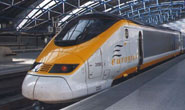Report warns high-speed rail may not be low carbon
 London, UK - Government-commissioned study calculates that carbon emissions resulting from building and operating high-speed rail link mean domestic flights could be greener on some routes
London, UK - Government-commissioned study calculates that carbon emissions resulting from building and operating high-speed rail link mean domestic flights could be greener on some routesA government-commissioned report has warned that the proposed new high-speed London to Manchester train link will generate more carbon emissions over the long term than using domestic airline services.
The study, undertaken by consultancy Booz Allen Hamilton and completed in 2007 although only released this year, appears to blow a hole in a key element of transport secretary Lord Adonis’ support for the high-speed rail line. He recently said that one of the main aims of building a high-speed rail network should be to phase out domestic flights because of their impact on the environment.
But the report, entitled Estimated Carbon Impact of a New North-South Line, said: “There is no potential carbon benefit in building a new line on the London to Manchester route over the 60-year appraisal period. In essence, the additional carbon emitted by building and operating a new rail route is larger than the entire quantity of carbon emitted by the air services.”
BAA, which owns Heathrow airport, added to the controversy by arguing that a new north-south link would boost the case for a third runway at the site, even if it replaced domestic air travel. This is because one of the proposals includes a link to Heathrow that would funnel even more passengers to the airport, putting further pressure on capacity.
However, the report did not deliver a killer blow to high-speed rail plans, calculating that if another planned high-speed route from London to Glasgow or Edinburgh were able to boost rail’s market share against airlines on the route from its current 15 per cent to a future 62 per cent, it would be possible to achieve net carbon savings.
Such a goal would be more difficult to realise for the London to Manchester route, however, as rail already controls about half the market.
The market share target would also become less attainable for the Scotland to London route if the number of trains were doubled from four to eight per hour. In this instance, market share would need to increase to between 73 and 85 per cent to achieve a net carbon saving.
As a result, one alternative for the government could be to focus on increasing capacity on existing lines. This would be possible by removing bottlenecks and introducing more advanced signalling systems, said the study.
But a Department for Transport spokesperson said the Booz Allen Hamilton report admitted that it was based on a “simplistic model” and had not factored in the possibility of winning over car drivers to train travel.
High Speed Two, the company set up by Lord Adonis to draw up plans for the north-south link, will submit its own report on the environmental impact of the proposed project at the end of this year.
You can return to the main Market News page, or press the Back button on your browser.

